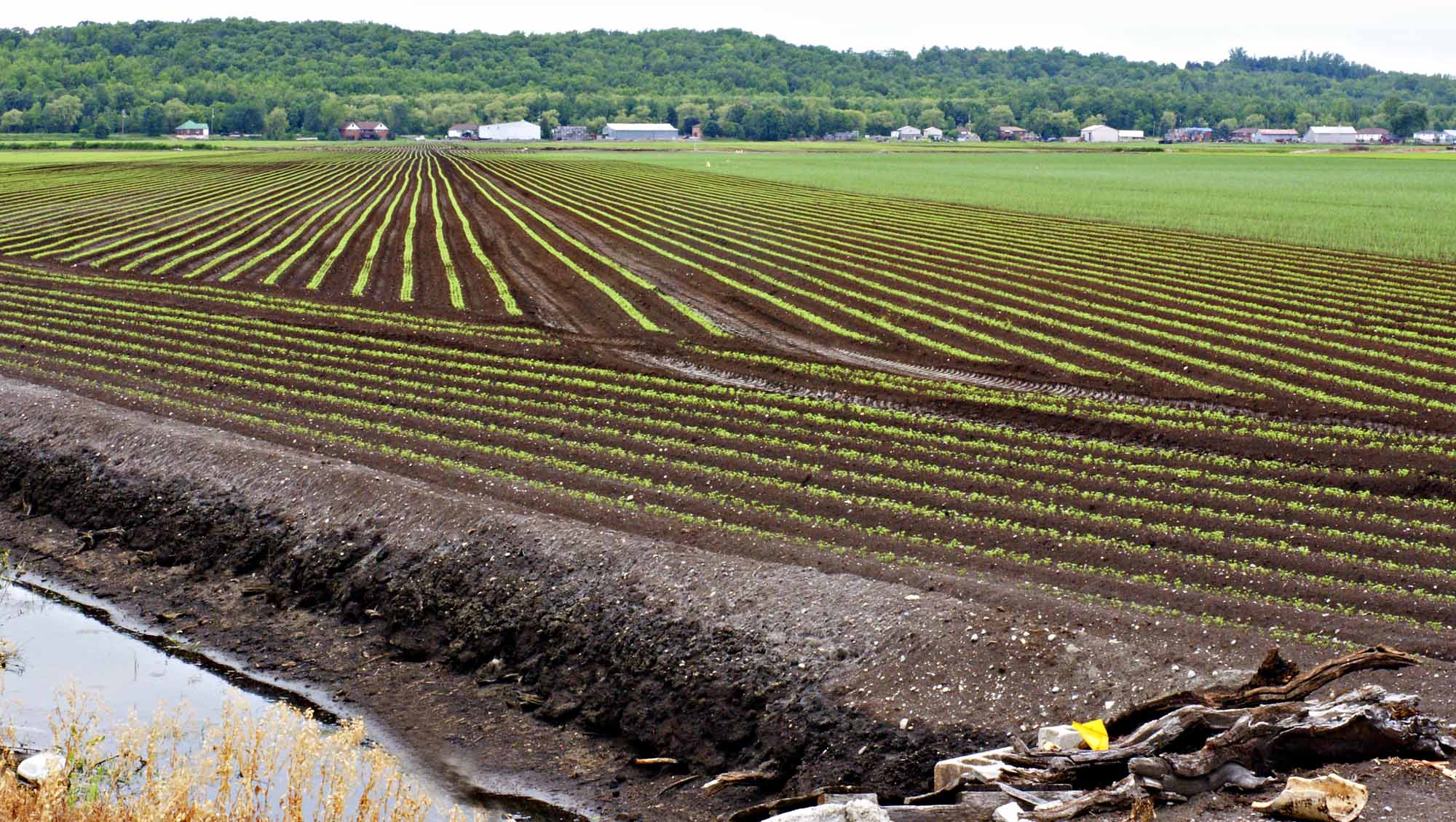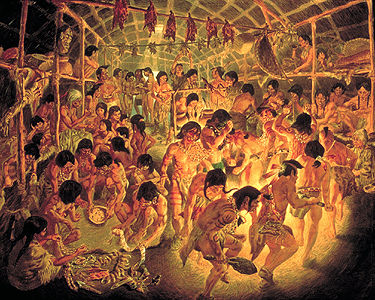Newmarket, Ontario, incorporated as a town in 1880, population 87,942 (2021 census), 84,224 (2016 census). Newmarket’s modern boundaries were created in 1971 from the town itself, and portions of the townships of King, East Gwillimbury, and Whitchurch (see Whitchurch-Stouffiville). Located within York Region, Newmarket is in the Toronto Census Metropolitan Area. Throughout history, the Newmarket area has been home to different Indigenous groups, namely the Wendat (Huron), Tionontati (Petun), Haudenosaunee and the Anishinaabeg. The land is covered by Treaty 13 and the Williams Treaties.
Indigenous Peoples
Indigenous peoples have lived in the Newmarket area for thousands of years. From the mid-15th century to the mid-17th century, the area was home to the Wendat (Huron) and Tionontati (Petun). During the Iroquois Wars of the mid-1600s, the Haudenosaunee, who at the time lived in what is now northern New York State, dispersed the Wendat and Tionontati. In the late 1600s, the Anishinaabeg moved from land north of Lakes Huron and Superior into Southern Ontario, pushing most of the Haudenosaunee back to New York State. Ancestors of the Chippewas of Georgina Island, an Anishinaabe nation, began living in the Lake Simcoe region. Today, two of this First Nation’s three reserves are located northeast of Newmarket, on the shore of Lake Simcoe and on Georgina Island (see also Reserves in Ontario). As of the 2021 census, Indigenous peoples make up 1.2 per cent of Newmarket’s population.
Treaties
Initially, the Upper Canada government acquired the land within Newmarket via the Johnson-Butler Purchase. While the first negotiations for this treaty took place in 1787 between the government and the Mississaugas, later discussions in 1795 and 1798 included the Chippewas of the Newmarket area.
The terms of the Johnson-Butler Purchase were poorly documented and unclear. Because of this the government brokered two new treaties, known as the Williams Treaties, with the Chippewa and the Mississauga in 1923. The Chippewas of Georgina Island signed the first of the two treaties, along with Chippewas of Rama and Christian Island.
In 1805, Mississauga chiefs met with colonial administrators and signed Treaty 13, also known as the Toronto Purchase (see Toronto Purchase (Treaty 13)). The treaty transferred approximately 250,800 acres (1,015 km2), including the southwestern corner of modern-day Newmarket, from the Mississauga to the colonial government. One of the townships created from this treaty’s land became King Township. Land southwest of Yonge Street and Davis Drive West was formerly that township.
Settlement and Development
In the late 1700s, Upper Canada Lieutenant-Governor John Graves Simcoe established roads to aid in the colony’s defence. One of them, Yonge Street, connected Lake Ontario and Lake Simcoe, passing through what would become Newmarket.
Simcoe wanted to settle the land between York (now Toronto) and Holland Landing (now part of East Gwillimbury). He granted free land to members of Pennsylvania’s Quaker community in 1801. These settlers quickly built a gristmill and storehouse in the Township of Whitchurch (see Whitchurch-Stouffiville).
As population increased, the area around the mill became a hub for those looking to avoid the long trek to York. Traders used the location to intercept Indigenous trappers to buy their furs, before they could sell to established dealers in Toronto (see Fur Trade in Canada). The area became a “new market” for goods, including produce from the Holland Marsh. This quickly attracted the attention of investors like Peter Robinson, who purchased land and businesses.
By the 1820s, development centred around an old Indigenous trail. This route became Newmarket’s Main Street. Newmarket grew north in 1853, extending to the new Ontario, Simcoe and Huron Railway station.
Newmarket became an incorporated village separate from Whitchurch Township in 1858. This gave the community its own council, with the ability to choose its own priorities, separate from its agricultural surroundings.
Newmarket itself was geographically small until the 20th century, surrounded by agricultural townships. After the Second World War, subdivisions actively replaced farmland, pushing the town borders outwards.
Population
Newmarket grew 4.4 per cent between the 2016 and 2021 censuses, slower than the overall growth in York Region of 5.7 per cent. At least 80 per cent of growth is in existing neighbourhoods, through “intensification.”
According to the 2021 census, prominent ethnic groups within the town include English (18.5 per cent), Irish (14.2), Scottish (14.1), Canadian (11.1), Chinese (9.7), Italian (8.5), German (6), Iranian (4.8) and French (4.7).
Economy and Labour Force
Notable employers include confectioners Mars Wrigley and Rockets Candy, and four divisions of auto parts manufacturer Magna International (Confectionery Industry; Automotive Industry). Newmarket’s single largest private employer, a call centre with over 900 employees, moved to Barrie in 2023.
Robert Simpson ran a dry goods store in Newmarket from 1858 to 1872, when he moved to Toronto. The department store Simpson then developed became the basis for a national chain called Simpsons. A pencil factory opened in Newmarket in 1920, was purchased by American pencil firm Dixon in 1931, and operated locally until 1990. Furniture maker Office Specialty employed 400 people in 1929, making them a major employer at a time when Newmarket’s population was roughly 3,700 (see Furniture Industry).
Government and Politics
Newmarket is represented by a mayor, a deputy mayor, and seven ward councillors (see Municipal Government). York Region’s 22-person council includes Newmarket’s mayor and deputy mayor.
The town deals with services including waste management, planning, roads and parks. York Region handles social services, public health and transit. York also handles water treatment and storage, but Newmarket handles the pipes to distribute it to users.
York Region’s offices are based in Newmarket.
Cultural Life

Municipal cultural venues include the Elman W. Campbell Museum, NewRoads Performing Arts Centre, and Old Town Hall, an arts hub. Many community events are held at the Newmarket Riverwalk Commons. Newmarket Citizens Band has operated continuously since 1872.
Newmarket previously was home to the Toronto Maple Leafs’ American Hockey League farm team, and an Ontario Hockey League team.
Author Lawrence Hill and actor Jim Carrey are from Newmarket. Historic residents include songwriter Alexander Muir and author Mazo de la Roche, both of whom are the namesakes of public schools.

 Share on Facebook
Share on Facebook Share on X
Share on X Share by Email
Share by Email Share on Google Classroom
Share on Google Classroom














